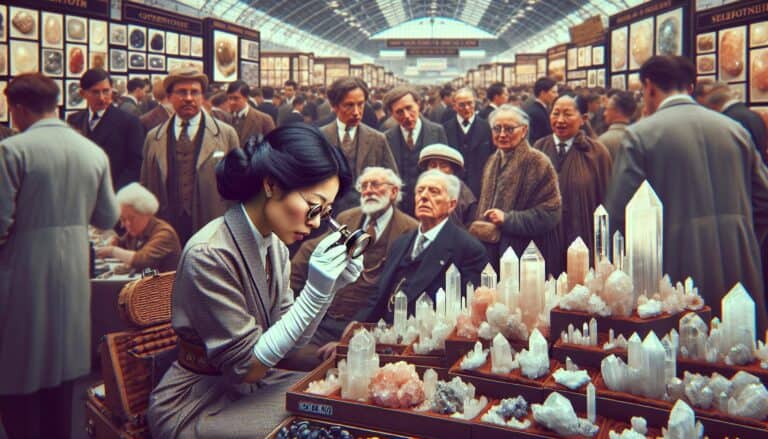Ever stumbled upon a piece of wood that looks like stone?
That’s petrified wood, a fascinating natural phenomenon that turns timber into a fossil through a process called permineralization. It’s not just a rock; it’s a snapshot of ancient life, frozen in time.
Petrified wood can be millions of years old, with some pieces dating back to the days of the dinosaurs. Imagine holding a piece of history that’s witnessed the earth’s incredible transformations.
Curious about how old your petrified wood might be? You’re about to find out.
Petrified wood results from permineralization, where minerals replace organic material, preserving intricate details. This fossilized wood, ranging from thousands to millions of years old, provides insights into Earth’s past vegetation and climates, making it valuable for scientific research and highly sought after by collectors and decorators.
What is Petrified Wood?
Imagine walking through a forest and stumbling upon a piece of wood that’s as hard as rock. You’re not just seeing things; you’ve found petrified wood. This stone-like material started out as a regular piece of wood that fell to the ground perhaps millions of years ago. Over time, it underwent a remarkable transformation through a process known as permineralization.
Permineralization occurs when minerals carried by groundwater replace the original organic material, cell by cell. Intricate patterns form as the minerals crystallize, preserving the wood’s structure. Silica is a common mineral in this process, often sourced from volcanic ash and carried by water. This replaces the wood’s cellular structure, sometimes even down to the microscopic level, turning wood into a fossil.
Petrified wood is a type of fossil that reveals stunning details of ancient trees. The colors of petrified wood, ranging from muted browns and grays to vibrant reds and greens, are the result of different minerals. Iron contributes to red and orange hues, while manganese can create pinks and purples. As the mineral-laden water seeps through the wood, it leaves behind a rainbow of colors.
Discovering a piece of this ancient wood is like holding a piece of history in your hands. The preservation of bark, annual rings, and sometimes leaves or seeds can provide a wealth of information about the tree and the environment it lived in. Petrified forests worldwide draw both scientists and enthusiasts eager to explore these natural time capsules. Some notable locations include Petrified Forest National Park in the USA and the Petrified Forest of Lesvos in Greece.
With its beauty and scientific importance, petrified wood is not just a geological marvel but also a much-sought-after item for collectors and decorators alike. Whether polished into gleaming gemstones or left in its natural state, this fossilized wood tells the story of our planet’s ancient biological and geological past.
The Process of Permineralization
When you hold a piece of petrified wood, you’re witnessing the result of a remarkable natural process known as permineralization. This process can take millions of years and involves several conditions that must be just right for wood to undergo this transformation.
Permineralization starts when wood becomes buried under sediment. It’s protected from decay due to a lack of oxygen. As time moves forward, mineral-rich water flowing through the sediment deposits minerals in the plant’s cells. While the original organic material gradually breaks down, it’s replaced by minerals, typically silica derived from volcanic ash or quartz. This combination carries forth the meticulous details of the wood.
The minerals that petrify the wood also contribute to its beautiful color variations. These hues are dependent on the presence of other minerals, such as iron, carbon, and manganese. Iron, for instance, can give the petrified wood a reddish or yellowish tint, while manganese can lead to pink or orange hues.
Here are some critical factors that contribute to petrification:
- Rapid burial is vital to protect wood from decay.
- Mineral-rich water must permeate the wood’s porous structure.
- The right minerals, like silica, play a central role in preserving wood.
Under certain rare conditions, the wood can petrify in less than a hundred years, but typically, this process spans centuries to millions of years. Various factors like the type of wood, sediment composition, and environmental conditions influence the rate of permineralization.
As petrified wood forms, the intricate structures such as tree rings become stones with the memory of their previous living state. This incredible process not only gives you a glimpse into the past lifeforms but also provides a tangible connection to the history of our planet.
Collectors and scientists cherish petrified wood, not just for its sheer beauty and rarity but also for the stories it tells—of ancient life, climatic shifts, and geological events that have shaped the Earth’s surface over eons.
Petrified Wood: More than Just a Rock
Petrified wood stands as a testament to the power of natural alchemy, transforming organic material into stone through the meticulous work of minerals and time. Often mistaken for mere rocks, these fragments of ancient arboreal life tell tales of the Earth’s lush past.
Each piece of petrified wood is a unique snapshot of the world millions of years ago, with intricacies hidden within its stony confines. When you hold a piece, you’re not just holding a rock; you’re holding a record of the atmospheric conditions, the climate, and even the specific location’s environmental past. Rockhounding researchers delve into its mineralized secrets to unravel the Earth’s ecological history, collecting data on past climates and the conditions that prevailed at that time.
Consider the worth of petrified wood in scientific studies:
- It helps paleobotanists understand flora evolution.
- It provides clues to ancient geographical landscapes.
- It sheds light on long-gone ecological systems.
Petrified wood is not confined to one age or period. It spans across various geological epochs, from the Carboniferous to the Miocene. The formation process is so gradual that petrified wood you come across today could range from 20 million to over 200 million years old. Recognizing the age of petrified wood relies on analyzing the surrounding sedimentary strata, often using radiometric dating techniques.
The commercial value of petrified wood has spurred a robust market. Its beauty captivates artists and decorators, while its rarity and age enchant collectors. The vibrant colors, driven by the type of minerals present during silicification, ensure that no two pieces are alike, making them highly desired for jewelry, furniture, and sculptural elements.
Bearing in mind the diversity and significance of petrified wood, it’s crucial to protect these natural artifacts. Several locations across the globe have been designated as protected areas to safeguard these geological treasures. By respecting these ancient relics, we maintain the integrity of their scientific, historical, and aesthetic values for future generations to study and enjoy.
The Ancient Origins of Petrified Wood
Petrified wood harks back to ancient times when living trees and lush vegetation covered the Earth. Through a process called permineralization, these once-living organisms were preserved. Your understanding of this process begins millions of years ago, when trees would fall and be buried under layers of sediment. Devoid of oxygen, the wood’s decay slowed to a crawl. Over time, mineral-laden water flowing through the sediment would deposit minerals in the wood’s cells.
Over the millennia, these minerals crystallize, often silicates such as quartz, effectively turning wood to stone. However, this transformation retains the original structure of the wood; fine details such as tree rings and the grain are often visible, giving us a rare glimpse into the world as it was when these trees were still alive.
Environmental conditions during the time of petrification played a crucial role. Factors like the mineral composition of the water, the rate of sedimentation, and geological events influenced the final appearance of the petrified wood. These conditions varied widely across different regions and through the ages, so samples of petrified wood can look incredibly diverse, ranging from vibrant to subdued colors.
Fascinatingly, certain areas on our planet, such as the Petrified Forest National Park in Arizona, are famous for the abundance of petrified wood, showcasing ancient forest ecosystems that have long since vanished. Similarly, areas in Argentina and Egypt are renowned for their extensive petrified wood collections.
Scientists utilize petrified wood to study ancient climatic conditions, analyze vegetative evolution, and understand sedimentation patterns of past geological periods. Your appreciation for these natural relics grows as you consider their role in piecing together the Earth’s long history, serving as stone time capsules that hold the key to understanding our planet’s complex past.
How to Determine the Age of Petrified Wood
Unlocking the age of petrified wood is akin to unwrapping a time capsule that’s been sealed for millennia. The process involves a blend of fieldwork, laboratory techniques, and comparative analysis. With science at your fingertips, you’ll grasp that dating petrified wood is an intricate part of understanding our planet’s history.
The initial step in age determination is often field stratigraphy. By examining the layers of sediment where the wood was found, you can infer a relative age of the specimen. Typically, the deeper the layer, the older the wood. However, for a more accurate age, scientists turn to radiometric dating methods.
One of the most widely used techniques for dating ancient woods is radiocarbon dating (C-14). This method is effective for organic materials up to around 50,000 years old. However, petrified wood often exceeds this age by far, which means other methods must be employed.
For older samples, geologists might rely on uranium-series dating or potassium-argon (K-Ar) dating. These methods are useful for timescales that stretch back hundreds of millions of years. Here’s a quick look at the ranges they cover:
| Dating Method | Effective Age Range |
|---|---|
| Radiocarbon (C-14) | Up to 50,000 years |
| Uranium-series | 50,000 to 500,000 years |
| Potassium-argon | 100,000 years to billions |
Microscopic analysis also offers clues to the wood’s age. The cell structures change over time; these changes can be mapped and compared to known evolutionary stages in plant life. Lastly, the fossil’s mineral composition might hint at its age, as certain elements are indicative of specific geological periods.
To get an even clearer picture, scientists also look at paleomagnetic data. The Earth’s magnetic field has reversed many times throughout history. By examining the minerals in the petrified wood that align with Earth’s magnetism, and comparing these to the geomagnetic reversal time scale, researchers can often pinpoint the wood’s age within a certain range.
Conclusion on What is Petrified Wood
You’ve journeyed through the fascinating world of petrified wood, uncovering its secrets and the window it provides into our planet’s ancient history.
With the knowledge that these stone-like forests can be as old as 200 million years, you’re now aware of the intricate processes scientists employ to reveal their age. It’s clear that petrified wood is more than just a beautiful specimen—it’s a vital link to understanding Earth’s evolutionary tale. Remember the importance of preserving these treasures, as they hold the key to unlocking mysteries of the past.
Embrace the awe that comes from holding a piece of history in your hands, and let’s ensure these natural wonders are protected for the curious minds of tomorrow.







